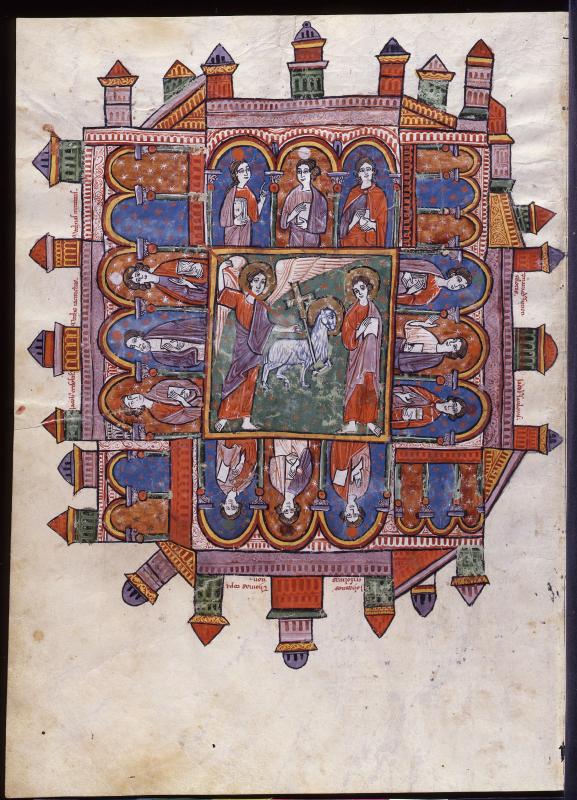
Commentary on the Apocalypse and commentary on the Book of Daniel
Purchased by J. Pierpont Morgan (1837-1913) in 1910
Apocalypse: New Jerusalem measured (Revelation 21:15-17) -- Precious stones, inscribed, above half figures of twelve apostles, some inscribed with name and precious stone, Simon, ZMARACDUS SIMON ZELOTES, Bartholomew, BARTHOLOMEUS SARDONIX, James, IACOBUS SARDONIS, John, IOHANNES CRISOLITUS, Thomas, THOMAS TOPATION, James, IACOBUS CRISOFASUS, Matthew, MATTHUS IACINCTUS, and Matthias, MATHIAS MITITEUS, holding books, in arcades of city wall of Jerusalem; in center, nimbed angel holding measuring rod, Lamb of God nimbed, holding cross-staff, and John nimbed, holding book.
Starred and decorated background.
And I, John, saw the Holy City, the New Jerusalem, descending out of heaven from God, prepared like a bride adorned for her husband. And one of the seven angels approached and spoke with me, saying: "Come, and I will show you the bride, the wife of the Lamb." And he took me up in spirit to a high mountain and showed me the descending Holy City Jerusalem, which was laid out as a square, with three gates on each side. At each gate was an angel with the name of one of the twelve tribes of the sons of Israel. The wall of the city had twelve foundations, each with the name of one of the twelve Apostles of the Lamb. And he who was speaking with me was holding a golden measuring reed to measure the city, its gates, and wall. The city was of pure gold, and the foundation walls were adorned with every kind of precious stone. The first foundation was of jasper, and the other eleven were of sapphire, chalcedony, emerald, sardonyx, sardius, chrysolite, beryl, topaz, chrysoprasus, jacinth, and amethyst. And I saw no temple in the city, for the Lord God Almighty and the Lamb are its temple. (Rev. 21:2–22)
Here the gates are filled with apostles, each with a book and a gemstone above his head. At left, for example, are James (chrysoprasus), Matthew (jacinth), and Matthias (amethyst). At center is the Lamb flanked by the angel with the measuring stick and John with his book. The city follows the ideal square city plan of the time.
